
 |
| With
56 hectares, corresponding to 1/3 of the whole area of the Ilha Grande
(Big Island), the State Park of Ilha Grande was created in l971,
aiming
the preservation of the natural resources and also to stimulate the tourism. The University of the state of Rio de Janeiro- UERJ has been developing a great project in order to be forgathered with the local community and wake this community up to be conscious about the valorization of citizenship, the preservation of the environment and the importance of a sustainable |
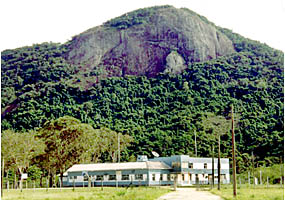 |
development.
For this, UERJ established the Center of Environmental Studies and Sustainable
Development – CEADS which gathers different environmental projects in many areas of the knowledge: Anthropology, Botany, Ecology, Environmental Education, Health Education, Fishing Engineering, Pharmacology, Geo-sciences, Nutrition, Oceanography, Sociology, Zoology. And, it is in Botany that Herbário Bradeanum (Bradeanum Herbarium) takes part of this important project doing researches about Vila Dois Rios Florule. |
| The
project (Abstract based on interviews, rapport and folders supplied by Bradeanum Herbarium). Although the vegetation of the Serra do Mar (Mar mountains) which surrounds the harbour of Ilha Grande has high diversity and high number of endemic and/or threatened species and in spite of being considered as one of the Brazilian center of the diversity of plants recognized by WWF – World Wide Found For Nature and IUCN – The World Conservation Union, the importance of this fact is not translated by the representation of those species in our herbariums. |
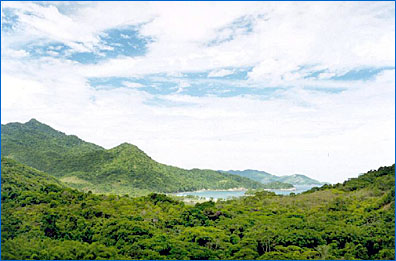 |
The project of surveying Vila Dois Rios Florule brings a great contribution to the study of the local flora, filling this gap as it aims the inventory of the remainder flora of slope Atlantic forest in the State Park of Ilha Grande, the amplification of the knowledge and the conservation of the floristic composition as well as the identification of endemic species and/or threatened by extinction. Thus, it goes on with the studies about the Orchidaceae family which were been accomplished by Bradeanum |
| Herbarium
since almost 50 years, besides amplifying the collection of Rio de Janeiro
flora, of Bradeanum Herbarium and UERJ Herbarium. To get those aims, a complete knowledge of the flora by collecting plants and taxonomical studies about the different botanical families which composed the Park became necessary. Ilha Grande is the biggest island of the state of Rio de Janeiro with, at about, 190km² and is located in Angra dos Reis municipal district. With its vast Atlantic Forest vegetation, it is considered as an ecological sanctuary. The climate of the region is hot and humid, without dry season and with an annual medium temperature at 22,5ºC, a maximum at about 25,7º, in February and a minimal at 19,6º, in July. The relief is uneven where Papagaio Peak, at 959m altitude and Serra do Retiro, 1031m are outstanding. It was, primitively, entirely covered by the tropical pluvial forest (Atlantic Forest) since the sea level until the highest points. Due to the different cycles by which the region went through since the colonial period (coffee, sugar cane and some others), the vegetation of the island which faces the continent is in state of degradation. The highest points have been more preserved because they are more inaccessible and from those remainders, the vegetation could recovered itself. The woods placed in the south versant and the geographical center are better preserved. Even though, the island represents, nowadays, one of the few vast areas of dense ombrophilous forest (dense tropical rain forest) in the State of Rio de Janeiro in different phases of conservation. That is in this area, in the confluence of those regions that the Center of Environmental Studies and Sustainable Development –CEADS-UERJ is placed and that is where the Bradeanum Herbarium, in association with the Animal and Vegetal Biology Department, develops the Project of Vila Dois Rios Florule. 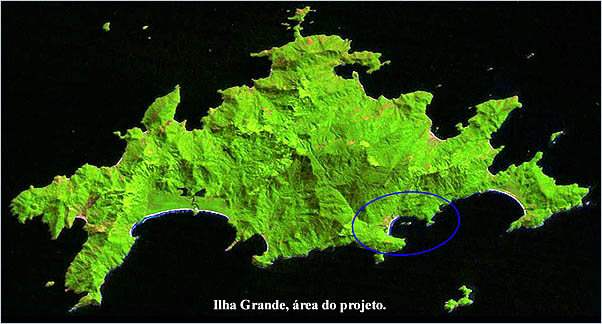 Embrapa-Monitored by satellite Inside the area of State Park, in the southeast face of the sea side, at the mouth of two rivers (Barra Grande and Barra Pequena), Vila Dois Rios project is located. This precisely location is the reason of its name which means "Two Rivers Village". |
| Nowadays
the new construction are forbidden but the old penitentiary ruins
are still
there. This area presents a slope Atlantic Forest vegetation, in different
stages of conservation, with the occurrence of primary forest in
areas which
access is really difficult, at 240m altitude. The
forest formation, though is practically continuos, is called by different
names according to the topography and points of reference: Mãe d’Água
dam, Caxadaço, Parnaióca and Jararaca. In spite of the modification provoked by the construction of the penitentiary with the dislocation of population, traffic of vehicles through Parnaióca trail mainly trucks, the introduction of exotic species, big plantations, there was a positive compensation concerning, mainly, the speculation with real properties. In a certain way, the island remained preserved, keeping away the construction of hotels, during the years 70/80. When the penitentiary closed the doors, there already was a certain environmental consciousness and there were plans to establish unites of preservations, forming biological corridors |
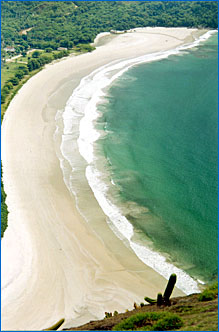 Dois Rios beach |
|
until
the south
of the country. Nowadays,
the few inhabitants are strongly involved with the preservation of island.
Jararaca (at 240m altitude) is a primary wood, located in higher areas with little human interventions and richer in Epiphyte. So, it presents a better stage of conservation with a canopy varying between 25 and 30m, many trees with 1.20m diameter and a deep layer of dropped leaves which can reach 120mm. There are many water sources which supply the Vila and this is an area of limited access where only the authorized people by UERJ can get in. The vegetation near by the region known as "Mãe d’Água fall" has been removed during the construction of the Penitentiary in order to allow the entrance of vehicles. When the Penal Colony closed the doors, 25 years ago, the area started its own process of regeneration, presenting, nowadays, a secondary wood rich in epiphytes, with species varying from 12 to 15m height. The secondary forest predominates in regions such as Parnaióca and Caxadaço where the sub-thicket is dense, predominating a wood with an entanglement of many thin climbing plants and a little number of epiphytes, except for some points in the interior where we can find authentic nooks with a vegetation very rich in epiphytes characterizing very well dense ombrophilous forest or Atlantic Forest. Besides, in many points of the forest, in general, in the direction of the beaches and falls, where the tourists go through, there are many degraded areas invaded by a species of pteridophyta. Caxadaço Forest has been in regeneration since, at about, 50 years ago. 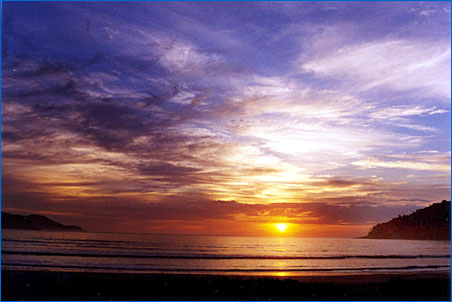 Sunrise at Vila Dois Rios |
 |
||
|
SPECIES
|
VEGETATIVE
GROWTH
|
PLACE
|
01 |
Aspidogyne argentea (Vell.) Garay | terrestrial | Caxadaço |
02 |
Aspidogyne fimbrillaris (B.S. Wms) Garay | terrestrial | Jararaca |
03 |
Cattleya forbesii Lindl. | Epiphyte/Rupicolous | Caxadaço, Mãe d'Água |
04 |
Cattleya guttata Lindl | Rupicolous | Parnaióca trail |
05 |
Cirrhaea dependens Rchb f. | Epiphyte | Jararaca |
06 |
Cleistes macrantha (Barb. Rodr.) Schltr. | Terrestrial | Mãe d'Água |
07 |
Cleistes sp. | Terrestrial | Abrahão road |
08 |
Cochleanthes wailesiana (Lindl.) Schultes & Garay | Rupicolous | Mãe d'Água |
09 |
Cyclopogon venustus (Barb. Rodr.) Schltr. | Terrestrial | Jararaca Trail |
10 |
Dichaea cogniauxiana Schltr. | Epiphyte | Jararaca Trail and Mãe d'Água |
11 |
Dichaea mosenii Cogn. | Epiphyte | Jararaca Trail |
12 |
Dichaea pendula (Aubl.) Cogn. | Epiphyte | Jararaca Trail and Mãe d'Água, Andorinha river margins |
13 |
Elleanthus brasilienis Rchb. f. | Epiphyte/Rupicolous | Jararaca and Mãe d'Água |
14 |
Epidendrum filicaule Lindl. | Rupicolous | Jararaca and Mãe d'Água |
15 |
Epidendrum fulgens A Brogn. | Terrestrial | Parnaióca |
16 |
Epidendrum latilabre Lindl. | Epiphyte | Mãe d'Água (margins) |
17 |
Epidendrum proligerum Barb. Rodr. | Epiphyte | Mãe d'Água (Dam and fall) |
18 |
Epidendrum ramosum Jacq. | Epiphytee Rupicolous | 100msm Jararaca and Mãe d'Água |
19 |
Epidendrum
rigidum Jacq. |
Epiphyte | Outcropping peak and Cavalinho |
20 |
Epidendrum rodiguesii Cogn. | Epiphyte | Jararaca |
21 |
Epidendrum denticulatum Barb. Rodr. | Rupicolous | Outcropping peak and Cavalinho |
22 |
Epidendrum paranaense Barb. Rodr. | Epiphyte | Jararaca |
23 |
Erythrodes arietina (Rchb. f. & Warm) Ames | Terrestrial | Jararaca and Parnaióca |
24 |
Erythrodes cotyledon Wawra | Epiphyte | Mãe d'Água |
25 |
Gomesa crispa (Lindl.) Akl. & Rchb. f. | Epiphyte | Jararaca and Mãe d'Água |
26 |
Habenaria leptoceras Hook | Terrestrial | Mãe d'Água |
27 |
Huntleya meleagris Lindl. | Epiphyte | Jararaca (trail) |
28 |
Liparis nervosa (Thunb.) Garay | Terrestrial | Jararaca and Caxadaço |
29 |
Malaxis parthoni C. Morr. | Terrestrial | Mãe d’Água |
30 |
Masdevallia infracta Lindl. | Rupicolous | Mãe d’Água (rock -100msm) |
31 |
Maxillaria brasiliensis Brieg & Illg. | Epiphyte | Caxadaço |
32 |
Maxillaria marginata Fenzl. | Rupicolous | Mãe d’Água |
33 |
Maxillaria rufescens Lindl. | Epiphyte | Mãe d’Água |
34 |
Maxillaria sp (Ornthidium) | Epiphyte | Mãe d’Água |
35 |
Miltonia spectabilis Lindl. var. moreliana | Epiphyte | Jararaca |
36 |
Myoxanthus punctatus (Barb. Rodr.) Luer | Epiphytee Terrestrial | Jararaca Trail and Mãe d'Água |
37 |
Octomeria grandiflora Lindl. | Epiphyte | Jararaca and Mãe d’Água |
38 |
Octomeria cf. stellaris Barb. Rodr. | Epiphyte | Mãe d’Água |
39 |
Octomeria cf. bradei Schltr. | Epiphyte | Mãe d’Água |
40 |
Octomeria grandiflora Lindl. | Epiphyte | Mãe d’Água and Jararaca |
41 |
Octomeria cf. grandiflora Lindl. | Epiphyte | |
42 |
Octomeria cf. bradei Schltr. | Epiphyte | Mãe d’Água |
43 |
Oeceoclades maculata (Lindl.) Lindl. | Terrestrial | Parnaióca and Caxadaço |
44 |
Phymatidium tillandsioides Barb. Rodr | Epiphyte | Jararaca |
45 |
Pleurothallis grobyi Lindl. | Rupicolous | Mãe d’Água |
46 |
Pleurothallis saundersiana Rchb. f. | Rupicolous | Rock Mãe d’Água |
47 |
Polystachya estrellensis Rchb. f. | Epiphyte/Rupicolous | Mãe d.Água and Parnaióca |
48 |
Prescottia plantaginea Lindl. | Terrestrial | Caxadaço |
49 |
Promenaea stapelioides Lindl. | Terrestrial | Rio das Pedras |
50 |
Prosthechea fragrans (Sw.) W.E. Higgins | Rupicolous | Parnaióca |
51 |
Prosthechea vespa (Vell.) W.E. Higgins | Rupicolous | Mãe d.Água |
52 |
Prosthechea pygmaea (Hook.) W.E. Higgins | Rupicolous | Mãe d'Água (50msm) |
53 |
Sophronitis cernua Lindl. | Rupicolous /Epiphyte | Parnaióca |
54 |
Stelis sp. (1) | Epiphyte | |
55 |
Stelis sp. (2) | Rupicolous | |
56 |
Stelis cf. pterostele Hoehne & Schltr. (3) | Epiphyte | Jararaca |
57 |
Stelis sp (4) | Epiphyte | |
58 |
Stelis sp. (5) | Epiphyte | |
59 |
Scaphyglottis modesta Schltr. | Rupicolous | Mãe d'Água |
60 |
Xylobium variegatum (Ruiz et Pavón) Mansf | Epiphyte | Jararaca |
Prof. Fontella 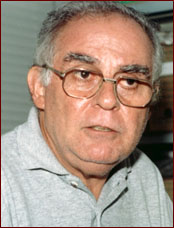 |
This project has the coordination of Professor Jorge Fontella Pereira, with the participation: Leonor Ribas de Andrade – Master in Flore and Faune Ecology – Universidade de Brasília Fernando da Costa Pinheiro – Master in Botany– Universidade Federal do Rio de Janeiro. Iranilda Calado Santana - Master in Botany- Universidade Federal do Rio de Janeiro Miriam Cristina Alvarez Pereira – Master in Ecology and Wild Life Conservation and Control - Universidade Federal de Minas Gerais Leonora Cardim – Herbarium Bradeanum trainee |
|
|
Angelo Carrancho Rayol – Herbarium Bradeanum trainee Sérgio Gonçalves - Biologist, speleologist and archaeologist. |
||
| All photos ©by Fernando Pinheiro |
| Any kind of reproduction (print, digital or anyone other) of any type of material of this site - texts, layout, photos, images and others - is strictly forbidden without the previous written permission of the authors. Any solicitation or information should be done by the e-mail bo@sergioaraujo.com |